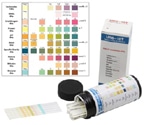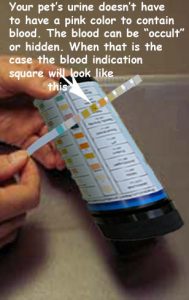Ron Hines DVM PhD
 See What Normal Blood & Urine Values Are
See What Normal Blood & Urine Values Are
 Causes Of Most Abnormal Blood & Urine Tests
Causes Of Most Abnormal Blood & Urine Tests
Blood In Your Pet’s Urine = Hematuria = hemoglobinuria
There should never be visible or invisible (occult) blood in your dog or in your cat’s urine. It is true that all the blood that is in your pet’s body eventually passes through its kidneys; but the many tiny filtering sieves and tubes in those kidneys (glomeruli & tubules) are designed to allow only excess fluid, salts and dissolved waste to pass through them and into the urine. Red and white blood cells can’t pass in significant numbers when your pet’s urinary tract is healthy.

Veterinarians generally use a simple dipstick like the ones above. They are thin, one-time-use, squares of thick absorbent paper that have been impregnated with chemicals that change color when they detect a wide variety of urine contents. The squares are attached to a thin plastic strip. One of the squares detects blood. It detects the peroxidase enzyme in hemoglobin that is normally present in all red blood cells. There should not be enough present in your pet’s urine to change the color of the strip.
When your pet has health issues, blood can be present in your it’s urine in large, visible amounts (frank blood) causing the urine to be pink to brownish. Or blood can be present in amounts so small that you cannot see it (occult blood). Whichever, a positive dipstick reaction indicates one of three things. Blood has leaked into your pet’s urine through some wound or defect somewhere between the filters and the point at which urine leaves your pet’s body or, hemoglobin has been released from red blood cells that are still circulating in your pet’s body. Hemoglobin, once released from injured red blood cells still in circulation, is not held back by the kidney sieves. A third possibility when the urine sample was collected through the cat or dog’s tummy is that the needle used penetrated the bladder in a way that caused bleeding (cystocentesis).
Of those three possibilities the first, blood leakage into the urinary tract, is the most common. The two major causes for that are a urinary tract infection (UTI) and urinary tract stones (calculi). Feline Urological Syndrome (FUS) is a common cause for blood to be present in the urine of male cats, while bladder infections are a more common cause in female dogs. Particularly in female dogs that were spayed at too young an age and/or overweight. Much less common causes for bleeding into the urinary tract are kidney infections and, in older pets, cancer. All the health problems that cause blood not to clot properly (coagulopathies) such as eating rodent poison, bone marrow cancers or genetic tendencies to bleeding, can also be responsible for blood being present in your pet’s urine.
The second group of possible causes occur when red blood cells that are still in your dog or cat’s circulation are destroyed in sufficient quantity so that the hemoglobin they contain spills over into your pet’s urine and gives a false indication of blood-cell leakage. This is called intravascular hemolysis. The most common reason for that to occur is an autoimmune disease in which your pet’s body has produced antibodies that destroy its own red blood cells (autoimmune hemolytic anemia or IMHA). It occurs more commonly in dogs than cats. For reasons unknown, 11-33% of the dogs experiencing IMHA are American Cocker Spaniels.
Even less common, red blood cell destruction can occur because of a transfusion reactions after your pet received a blood transfusion. That can be due to a prior transfusion (even when it was just plasma or serum) or due to antibodies (alloantibodies) stimulated by a prior pregnancy/delivery. Some cats appear to naturally possess antibodies that can destroy transfusion blood even if it was the first time they receive it. That results in hemoglobinemia and occasionally hemoglobinuria.
hemoglobinuria, resulting in a positive urine blood reaction can also occur in cats or dogs that have been bitten by coral snakes or fire ants. It has also been seen in dogs that ate or drank automatic dish washing detergent.
When red blood cell destruction occurs in the circulation of cats, feline leukemia, Mycoplasma hemofilis (aka haemobartonella), Cytauxzoon felis, cholangiohepatitis or lymphoma have all been identified as the underlying cause. It has also been reported to have occasionally occurred as a drug reaction in cats receiving methimazole for hyperthyroidism.
Certain bacteria involved in blood infections (septicemias) liberate toxins that can also be the cause of high levels of free hemoglobin that pass into the urine. (read here)
On rare occasions, severe muscle damage or overexertion will release muscle myoglobin into the blood stream (myoglobinemia), which will also make the standard urine dipstick test falsely appear positive for blood.
Complementary tests:
CBC and blood chemistry panel, particularly CK if myoglobin from muscle trauma is suspected, Re-do the dipstick test if color change is borderline, complete urinalysis, abdominal x-rays, abdominal ultrasound, coagulation blood test panel if clotting defect is suspected, bacterial culture and an antibiotic sensitivity test if bacteria were found in the urine, cystoscopy, laparoscopy
DxMe
You are on the Vetspace animal health website
Visiting the products that you see displayed on this website help pay the cost of keeping these articles on the Internet.


 \
\